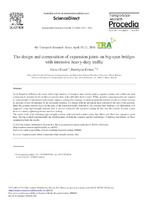| dc.contributor.author | Busel, A. | |
| dc.contributor.author | Krotau, R. | |
| dc.date.accessioned | 2018-03-10T17:12:55Z | |
| dc.date.available | 2018-03-10T17:12:55Z | |
| dc.date.issued | 2016 | |
| dc.identifier.citation | Busel, A. The design and composition of expansion joints on big-span bridges with intensive heavy-duty traffic / A. Busel, R. Krotau // 6th Transport Research Arena (April 18-21, 2016, Warsaw, Poland). – 2016. – Vol. 141. – P. 3953-3962. – (Transportation Research Procedia). – DOI: 10.1016/j.trpro.2016.05.488. | en |
| dc.identifier.uri | https://rep.bntu.by/handle/data/38496 | |
| dc.description.abstract | In the Republic of Belarus the roads with a high intensity of transport most widely employ expansion joints with rubber and steel compensators fastened to the reinforced concrete base with embedded therein studs. While operated expansion joints are exposed to various kinds of operational and climatic impacts causing their damage. Expansion joints destruction results in a sharp increase in dynamic effects of transport on the structural elements of a bridge with the pavement most affected in the area of the junction. Since the greatest stresses occur in the area of the expansion joints fastened to the concrete base leading to its destruction it is suggested using high-strength concrete able to receive elastically the dynamic loading. In this case the content of joints comes down to a timely tightening of nuts and their sealing. The article deals with obtaining high-strength concrete with activated crushed stone, fine fillers and fibers for expansion joints base. Having studied experimentally the reinforcement of both the concrete and the technology of making foundations we have summarized here the results. | en |
| dc.language.iso | en | en |
| dc.title | The design and composition of expansion joints on big-span bridges with intensive heavy-duty traffic | en |
| dc.type | Working Paper | ru |
| dc.identifier.doi | 10.1016/j.trpro.2016.05.488 | |

